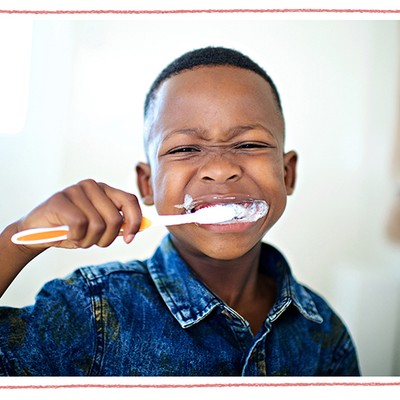
How To Care For Your Children’s Teeth

Start brushing your child’s teeth twice a day as soon as their milk teeth appear. Babies tend to swallow toothpaste on reflex, but try to encourage them to spit it out so they don’t swallow too much fluoride. Between the ages of three and seven, aim for children to brush their teeth twice a day for two minutes at a time, after breakfast and before bed, using fluoride toothpaste. For ages eight plus, children should be trusted to take on the task themselves, although it’s worth supervising to make sure they get to all those tricky to reach spots.

Experts advise taking your child for their first dentist appointment when their milk teeth start to come through, usually some time before their first birthday. As Dr Fattaneh Entekhabi, a paediatric dentist from Glow Dental explains: “It can be tricky to examine a very small child, so we recommend parents bring children to their own appointment, so the toddler can see how it’s done. We try to engage them by having their teeth counted and they get a sticker, too." Becoming familiar with the environment and getting to know their dentist is an important way to make it a positive and fun experience. “We encourage parents not to pass on their own anxieties to their child,” adds Dr Entekhabi.

Tooth Decay
Tooth decay is a process in which bacteria in the mouth metabolises sugar to produce acid which initially softens the tooth enamel. Once softened, bacteria can penetrate the tooth causing holes that need filling. Try not to let your children consume too much sugar, which can be found in everything from fruit juice to ketchup. Dr. Hooman Sanaty, cosmetic dentist, recommends fissure sealants to reduce the risk of cavities. “Fissure sealants are plastic coatings that are painted on to the grooves of the back teeth. These can be painted on as soon as the molars appear – typically from age six upwards – forming a protective layer that lasts for years. It will keep food and bacteria from getting stuck in the teeth and causing decay.”
White Spots
These can be caused by childhood illness, by dental fluorosis (when too much fluoride is ingested), irregular enamel formation or trauma to a baby tooth. Dr Sanaty says resin infiltration can be used to eliminate the white spot without the use of drilling or filling, although it will depend on how deep the lesion is. “In more severe cases, restorative methods such as composite bonding could be used and veneers may be an option later on,” he adds.
Thumb-Sucking & Dummies
Up to 75% of under-fives suck their thumbs or fingers, although experts agree most children grow out of the habit by the time they're seven. For dummy suckers, dentists recommend trying to force babies to give it up by the age of three to avoid any long-term consequences. Dr Amina Abdel Karim, specialist orthodontist and consultant from the Covent Garden Dental Spa says successfully stopping the habit by age nine means any unwanted effects on the bite or teeth should improve. “If the habit continues past that age, it can lead to protruding front teeth, an anterior open bite (where the front teeth don’t meet the bottom teeth), cross bites (a lateral misalignment) or even a narrow smile.” Dr Abdel Karim, meanwhile, recommends counselling or even Cognitive Behavioural Therapy (CBT). “These are very effective treatments, as are physical barriers like thumb guards, mittens or socks worn on the hands.” If all else fails, try using habit breakers or expander braces. “Habit breakers can be fixed or removable, and disrupt the “comforting” sensation, making the child more likely to stop. Expander braces also correct the narrowness caused by thumb-sucking.”

As Dr Abdel Karim explains, it’s a common misconception to wait until all your child’s adult teeth have all come through before taking them to the orthodontist. Instead, consider taking them around age eight or nine when they still have a mix of adult and baby teeth. This way, any serious issues can be intercepted, allowing you to work out the best course of treatment. “Thumb sucking habits and cross bites are best managed early. And if the appearance of your child’s teeth is causing them distress, it’s better not to wait to start a course of treatment.”

For children under the age of 10, removable braces will work to correct the bite, expand the smile and straighten the teeth. For older children, when nearly all the adult teeth are through, patients can choose between:
Labial Braces (“Train-Tracks”)
These are attached to the external side of each individual tooth and can be metallic or ceramic. Ceramic brackets are clear and offer a more subtle aesthetic during treatment.
Lingual Braces
These are attached to the inside of the teeth – making them completely invisible. They offer the precision of fixed braces, without the self-conscious smile.
Invisalign Braces
Transparent aligners are changed every seven to ten days, and gradually straighten the teeth over time. Children remove these braces when eating or brushing, and while they tend to be a more popular choice, it often involves more visits to the dentist. Braces tend to stay on for between one to two years depending on the complexity of the realignment.
For more information on children's oral health visit NHS.co.uk
DISCLAIMER: We endeavour to always credit the correct original source of every image we use. If you think a credit may be incorrect, please contact us at info@sheerluxe.com.